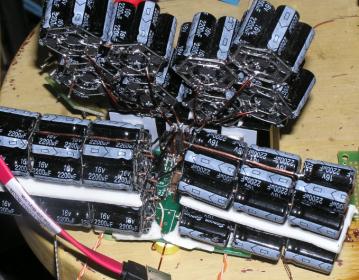Last night I was playing with attaching a line-level passive filter to this amp (see my blog), it didn't improve the sound, rather lost some of the ambience, bringing the image of the piano too forward. There was also some low level hum, so its back to the drawing board. In the process though I made rather an interesting discovery, since I was comparing the sound of two amps - one modded with the filter and one in the original form. That was - different SMPSUs sound different with this amp. There seemed to be a fairly major improvement in bass dynamics in swapping PSUs, that's something I'd like to get to the bottom of. I think perhaps I'm not using enough electrolytics in the decoupling...
Possibly the most frugal high-end sounding amp?
- Thread starter opus111
- Start date
You are using an out of date browser. It may not display this or other websites correctly.
You should upgrade or use an alternative browser.
You should upgrade or use an alternative browser.
Yes, it seems that I was using insufficient electrolytics - I bumped it up to 3 low ESR Rubycons (390uF each) per side and the previously 'bad' PSU sounds fine now. This got me thinking about Frank's suggestion of listening to what's happening on the power supplies. So I set up my trusty Sony PCM recorder to tape the signal on one channel (attenuated 40dB) and the power supply rail on the other. Here's a plot to show the result - the gain difference of 40dB turned out to be a bit too great so I've bumped up the gain on the music signal here by 10dB, now the bottom plot (PSU noise) is amplified 30dB wrt the top.
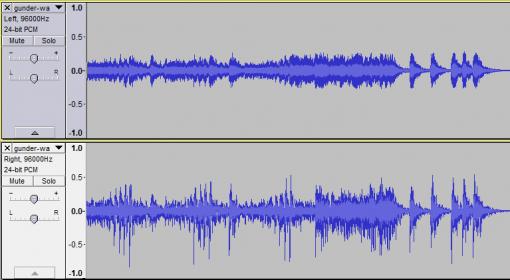
This is the closing bars of Gunter Wand's Beethoven Symphony No.1, first movement. The averaged PSU noise (just that busy section past half-way) in the frequency domain looks like this:
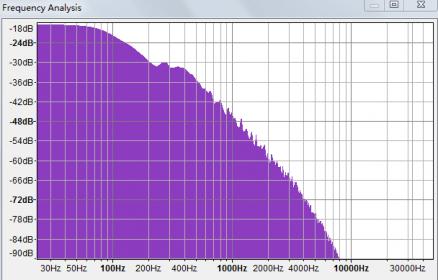
As I've now caught the 'how big a cap can you have on your PSU' bug, here's the FFT with a 10,000uF Nichicon at the output of the CM choke:
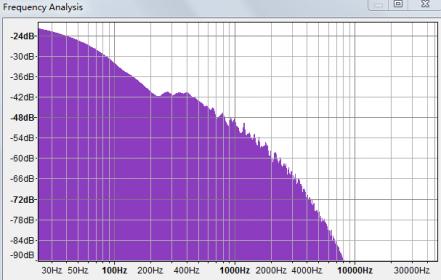
The LF PSU noise has gone down by around 10dB at 200Hz, not to be sniffed at

This is the closing bars of Gunter Wand's Beethoven Symphony No.1, first movement. The averaged PSU noise (just that busy section past half-way) in the frequency domain looks like this:

As I've now caught the 'how big a cap can you have on your PSU' bug, here's the FFT with a 10,000uF Nichicon at the output of the CM choke:

The LF PSU noise has gone down by around 10dB at 200Hz, not to be sniffed at
Last edited:
Although it all looks great on paper, the subjective effect of the new ultra-low LF noise PSU leaves me less than satisfied. What a can of worms I've opened up now  Ambience cues are not nearly so impressive with the big cap in circuit so I wonder if the issue is that the increased LF currents through the ferrite beads to each channel are reducing their effectiveness at RF. To test this I'll have to move the cap to the amp side of the beads, which necessitates two caps rather than one, hence I'll do this with 4,400uF per side and listen again....
Ambience cues are not nearly so impressive with the big cap in circuit so I wonder if the issue is that the increased LF currents through the ferrite beads to each channel are reducing their effectiveness at RF. To test this I'll have to move the cap to the amp side of the beads, which necessitates two caps rather than one, hence I'll do this with 4,400uF per side and listen again....
<later> Ah, nothing to do with that - the grounding of the cap is crucial, I had it across the CM choke output, seems it needs to go to the star earth....
<later> Ah, nothing to do with that - the grounding of the cap is crucial, I had it across the CM choke output, seems it needs to go to the star earth....
I managed to blow up one chip from connecting 40,000uF (4 paralleled 10,000uF) - not sure how but it won't come out of mute now. So I've now reverted to listening to my 2nd prototype which does work with the 40,000uF array connected - significant improvement in bass dynamics for sure. Then I returned to simulation to see how the different capacitors are contributing to the impedance of the PSU and found that my ferrite beads are a significant weak link - they need moving to the input. I'll go out and get some slightly smaller values of cap today at the electronics market (2,200uF) and parallel them. Smaller values mean they can be placed physically closer and hence there'll be less inductance and resistance. Suffice to say I won't be going back to lower values on the supply - the impact of Paul Lewis's piano in the lower registers now is only a whisker short of phenomenal 
LF wideband noise of solid state power supplies using SS regulators is much worst than people can expect. Recently I assembled a jig to test and select 6h30 tubes (my equipment needs 24 of them). I used SS regulators in the power supply and found that the noise induced by the power supply between 5 and 20 Hz was greater than the noise of the tubes themselves in a simple triode amplifier circuit. I had to use a multistage choke and capacitor filter in order to lower it to a level that would not affect the tube measurement.
Which particular regulators were you using? LM317s? If so, did you hang a big capacitor off the ref pin? If not, then that's a likely reason you got high LF noise. As far as I'm aware, no SS regulators in my PSU, they'd clobber the efficiency of the brick. Multistage LC filtering rocks for power supplies coming off the mains at mains frequency, with a switcher just a few judiciously placed ferrite beads and lots of ceramics look to be sufficient to smother the HF noise.
Fourth prototype build
A colleague locally has laid out a PCB for this amp, this is an early test of some EDA software he's written for schematic capture and layout. Here's how the souped-up Nitro looks with the additional capacitors - around 15,000uF per channel. The low ESR caps are on the other side of the board.
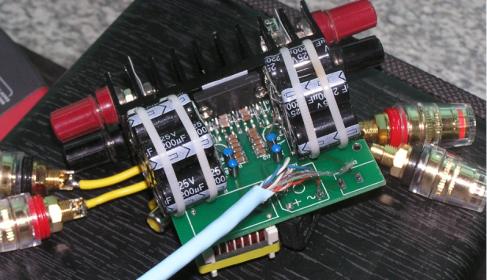
A colleague locally has laid out a PCB for this amp, this is an early test of some EDA software he's written for schematic capture and layout. Here's how the souped-up Nitro looks with the additional capacitors - around 15,000uF per channel. The low ESR caps are on the other side of the board.

The capacitor bug is still biting me hard - the tie-wrapped parcels of capacitors visible in the above picture I call 'hexacaps'. They're 7 caps in a parcel, I found I got audible improvements by adding two more either side, connected via twisted pairs. This gives a total supply capacitance around 46,000uF per channel. The power supply noise has gone down accordingly - here's a plot with the gain difference now 50dB between the music (top) and the power (bottom).
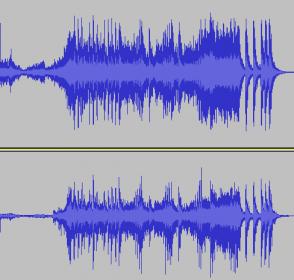
There's another addition in this case - a linear regulator (LM338K) feeding the supply via a small inductor so as not to compromise its stability into such a huge capacitance.

There's another addition in this case - a linear regulator (LM338K) feeding the supply via a small inductor so as not to compromise its stability into such a huge capacitance.
I've built a new version of the amp which keeps the linear regulator for lower LF supply impedance, but instead of the LM338K I've split this into two smaller package devices (LM350T). The reason for this is that being TO220 packages they can be placed right next to the amp chip on the same heatsink. Closer proximity means lower resistance connections.
Another modification has been to make a slight reduction in the supply voltage to the chip, for the purpose of being able to use lower voltage capacitors (16V) - these take up significantly less space than the 25V ones I was using previously. Meaning I can get more uF close in to the chip. Running the chip at 15.5V now means I can run comfortably from a 20V brick supply with enough headroom for the regulator. The brick supply, being a SMPSU, needs fairly aggressive filtering and this comes in three stages - two of normal mode and one of common-mode. For normal (differential) mode, HF filtering is done with ferrite beads and clamps, together with ceramic caps then there's audio band filtering with metal powder toroidal chokes, with electrolytics as the shunt elements. The common-mode filter has been moved to the mains side (so as not to compromise the output impedance of the brick) - I'm using the same segmented former but with thinner wire. Getting the filtering good enough has been rewarded with an expansive soundstage, something I've never achieved with any previous chipamp design using the usual suspects.
Another modification has been to make a slight reduction in the supply voltage to the chip, for the purpose of being able to use lower voltage capacitors (16V) - these take up significantly less space than the 25V ones I was using previously. Meaning I can get more uF close in to the chip. Running the chip at 15.5V now means I can run comfortably from a 20V brick supply with enough headroom for the regulator. The brick supply, being a SMPSU, needs fairly aggressive filtering and this comes in three stages - two of normal mode and one of common-mode. For normal (differential) mode, HF filtering is done with ferrite beads and clamps, together with ceramic caps then there's audio band filtering with metal powder toroidal chokes, with electrolytics as the shunt elements. The common-mode filter has been moved to the mains side (so as not to compromise the output impedance of the brick) - I'm using the same segmented former but with thinner wire. Getting the filtering good enough has been rewarded with an expansive soundstage, something I've never achieved with any previous chipamp design using the usual suspects.
Here's how the listening prototype is looking now - I call it the 'Leaning Tower of Song' (been listening to a lot of Leonard Cohen through it  ). So far no end in sight to the improvements arising from more capacitors - this incarnation has about 75,000uF per channel (5 hexacaps each side). Adding caps has the effect of reducing the LF noise floor, so previously unnoticed LF information becomes remarkably apparent, rather like listening on headphones. The kinds of things I mean are breathing from musicians, off-stage noises, plus the soundstage taking a more solid, palpable form in the rear corners. Most addictive which is why today I bought 6 * 68,000uF caps to try along with another 500 of the smaller caps for paralleling. I don't know yet what the ideal number of capacitors is going to be, that's the fun of the journey...
). So far no end in sight to the improvements arising from more capacitors - this incarnation has about 75,000uF per channel (5 hexacaps each side). Adding caps has the effect of reducing the LF noise floor, so previously unnoticed LF information becomes remarkably apparent, rather like listening on headphones. The kinds of things I mean are breathing from musicians, off-stage noises, plus the soundstage taking a more solid, palpable form in the rear corners. Most addictive which is why today I bought 6 * 68,000uF caps to try along with another 500 of the smaller caps for paralleling. I don't know yet what the ideal number of capacitors is going to be, that's the fun of the journey...
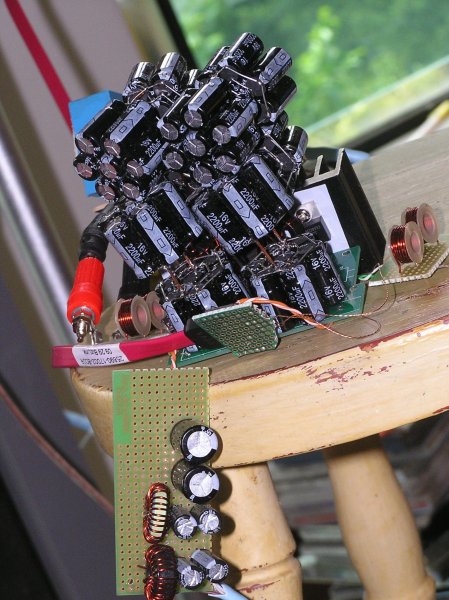
The audio from the Ozone DAC appears in balanced form over the red SATA cable. The SMPSU LF pre-filter is the lower PCB, there's just one of the two regulators visible on the heatsink.

The audio from the Ozone DAC appears in balanced form over the red SATA cable. The SMPSU LF pre-filter is the lower PCB, there's just one of the two regulators visible on the heatsink.
Hi,
i have aqquired some TDA8566Q chips. Read through all of the topic of this build. And the last pics got me thinkering about the lot of capacitors you have there. My chips are comeing form BMW HiFi DSP ampilifier that contains 4x TDA8566Q + 2xTDA1562Q (i supose they are for subwoofers), and there are only few electrolytic capacitors there - 6x2200uf for power supply (each chip has one), and 4x10000uf as lift capacitors for tda1562q.
Is the capacitor count related to PSU type, as that amp runs form car battery, not from a smps power supply like in your case?
i have aqquired some TDA8566Q chips. Read through all of the topic of this build. And the last pics got me thinkering about the lot of capacitors you have there. My chips are comeing form BMW HiFi DSP ampilifier that contains 4x TDA8566Q + 2xTDA1562Q (i supose they are for subwoofers), and there are only few electrolytic capacitors there - 6x2200uf for power supply (each chip has one), and 4x10000uf as lift capacitors for tda1562q.
Is the capacitor count related to PSU type, as that amp runs form car battery, not from a smps power supply like in your case?
My amp is running from an SMPSU but that's not the whole story as I have a linear regulator after the switcher. That's employed in a bid to get the output impedance as low as possible. The caps are also used to the same end - I want the lowest possible supply impedance as this results in the best dynamics. The subjective effect is that there's more 'texture' to bass lines, low-level details on recordings become more apparent. I doubt whether such improvements would be apparent in an in-car application as there's too much external noise, hence no incentive for BMW to use more caps. My chips came out of some 'Bose' equipment as they have that brand name stamped on them.
Can't resist continuing to add capacitors - now up to 70 * 2200uF per channel
View attachment 9232
But I do need a way to make this a manufactureable item somehow and I'm still scratching my head as to how to incorporate this number of capacitors in a production build, but in a rather more elegant manner....
You do need to find a way to "pretty it up." That is a kludge with a capital "K."
Its not so much that I have a need to pretty it up, rather it needs to be more manufactureable and less fragile, hence more reliable. The market I'm aiming for won't care how it looks inside the box as they're unlikely to open it.
If you're referring to the common-mode choke, its only called for when used with a switching supply. The amp works without it just doesn't have the depth of soundstage (so I'd not call it 'high-end') if its omitted. With a regulated linear supply it wouldn't be needed.
Similar threads
- Replies
- 1
- Views
- 879
- Replies
- 54
- Views
- 4K
- Replies
- 2
- Views
- 386
- Replies
- 6
- Views
- 444


